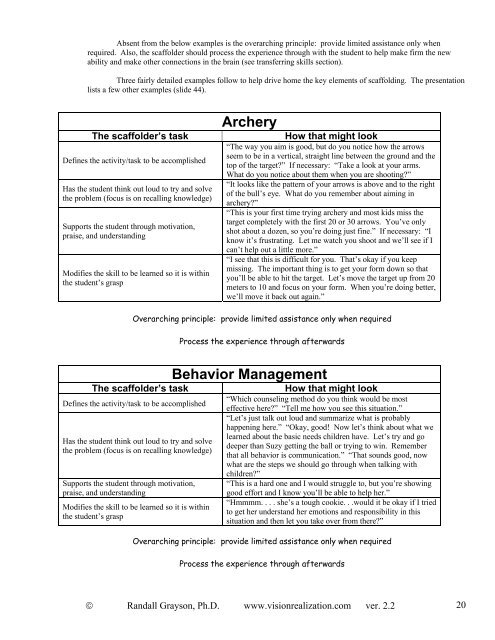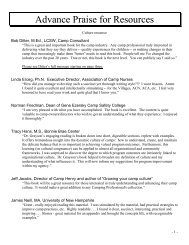Taking Camp Staff Training From Good To Best ... - Vision Realization
Taking Camp Staff Training From Good To Best ... - Vision Realization
Taking Camp Staff Training From Good To Best ... - Vision Realization
You also want an ePaper? Increase the reach of your titles
YUMPU automatically turns print PDFs into web optimized ePapers that Google loves.
Absent from the below examples is the overarching principle: provide limited assistance only when<br />
required. Also, the scaffolder should process the experience through with the student to help make firm the new<br />
ability and make other connections in the brain (see transferring skills section).<br />
Three fairly detailed examples follow to help drive home the key elements of scaffolding. The presentation<br />
lists a few other examples (slide 44).<br />
Archery<br />
The scaffolder’s task How that might look<br />
“The way you aim is good, but do you notice how the arrows<br />
seem to be in a vertical, straight line between the ground and the<br />
Defines the activity/task to be accomplished<br />
top of the target?” If necessary: “Take a look at your arms.<br />
What do you notice about them when you are shooting?”<br />
“It looks like the pattern of your arrows is above and to the right<br />
Has the student think out loud to try and solve<br />
of the bull’s eye. What do you remember about aiming in<br />
the problem (focus is on recalling knowledge)<br />
archery?”<br />
“This is your first time trying archery and most kids miss the<br />
target completely with the first 20 or 30 arrows. You’ve only<br />
Supports the student through motivation,<br />
shot about a dozen, so you’re doing just fine.” If necessary: “I<br />
praise, and understanding<br />
know it’s frustrating. Let me watch you shoot and we’ll see if I<br />
can’t help out a little more.”<br />
“I see that this is difficult for you. That’s okay if you keep<br />
missing. The important thing is to get your form down so that<br />
Modifies the skill to be learned so it is within<br />
you’ll be able to hit the target. Let’s move the target up from 20<br />
the student’s grasp<br />
meters to 10 and focus on your form. When you’re doing better,<br />
we’ll move it back out again.”<br />
Overarching principle: provide limited assistance only when required<br />
Process the experience through afterwards<br />
Behavior Management<br />
The scaffolder’s task How that might look<br />
“Which counseling method do you think would be most<br />
Defines the activity/task to be accomplished<br />
effective here?” “Tell me how you see this situation.”<br />
“Let’s just talk out loud and summarize what is probably<br />
happening here.” “Okay, good! Now let’s think about what we<br />
learned about the basic needs children have. Let’s try and go<br />
Has the student think out loud to try and solve<br />
deeper than Suzy getting the ball or trying to win. Remember<br />
the problem (focus is on recalling knowledge)<br />
that all behavior is communication.” “That sounds good, now<br />
what are the steps we should go through when talking with<br />
children?”<br />
Supports the student through motivation, “This is a hard one and I would struggle to, but you’re showing<br />
praise, and understanding<br />
good effort and I know you’ll be able to help her.”<br />
“Hmmmm. . . . she’s a tough cookie. . .would it be okay if I tried<br />
Modifies the skill to be learned so it is within<br />
to get her understand her emotions and responsibility in this<br />
the student’s grasp<br />
situation and then let you take over from there?”<br />
Overarching principle: provide limited assistance only when required<br />
Process the experience through afterwards<br />
© Randall Grayson, Ph.D. www.visionrealization.com ver. 2.2 20





